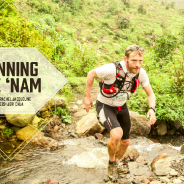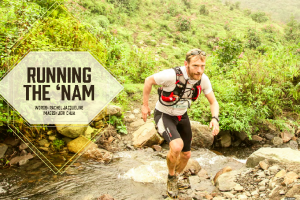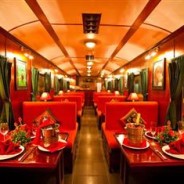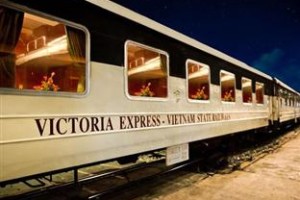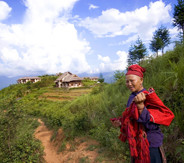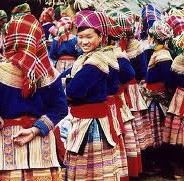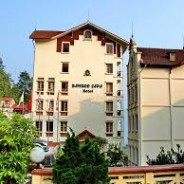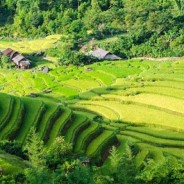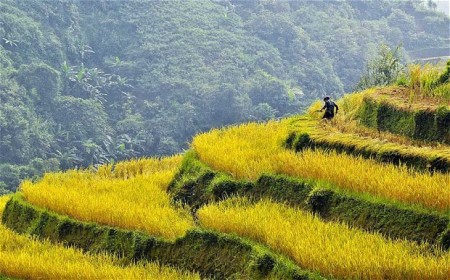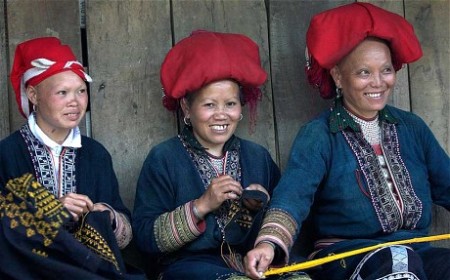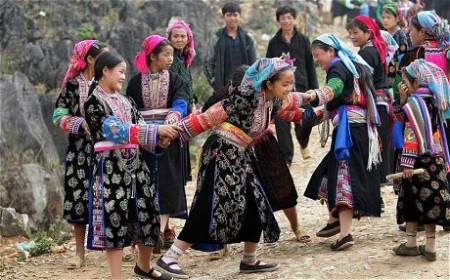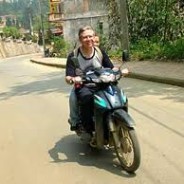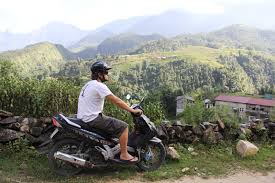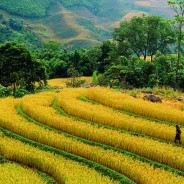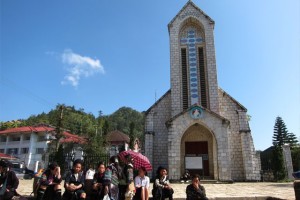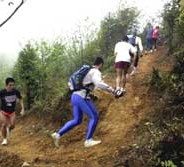Travel Blog
Mountain Marathon in Sapa 2014
Unique trail runs of 10km, 21km, 42km or 70km in a spectacular mountain region of north Vietnam.
Welcome to the mountains of Vietnam to thousands of yellow rice fields, water buffaloes and colorful ethnic minority groups. The small dirt roads and narrow trails will take you through the majestic mountains and valleys that are only used by locals. Each route will encompass challenging climbs, exhilarating descents and a true glimpse of local life through the rice fields and ethnic minority villages.
In general
The trails – with cumulative positive vertical meters ranging from around 1000m (21km) to round 3000 meters (70km) – will be on a marked route, tagged at crucial navigational points. Water and fruit will be available at aid stations every 10-15km. Runners doing the marathon or the ultra-distance must bring their own additional energy bars, gel or personal food and other important mandatory equipment (see equipment). Given the altitude and general hard conditions this cannot be your first Full or Ultra Marathon.
Very strong sun or heavy rain is always a possibility in the mountains. Any participation in this unique event is completely at your own risk and
you will be required to sign a waiver in order to participate.
After the race we will enjoy the very special social life of mountain runners and a good meal around a big bonfire where we can share our running experiences, the mountains and the twinkling stars above. Bring your family, your friends or join this unique event on your own. You don’t have to be a fast runner, but you better be tough and looking for a unique adventure of hiking or running.
Organizer: Topas Ecolodge
Date: 18-22nd of September 2014. (Race day 20th of September)
This run is arranged by Topas Travel, Topas Ecolodge and The Danish Embassy in Vietnam. The run is a social event, planned and organized by runners for runners, nature lovers and people who want an extraordinary, remote and unique experience.
The event is a result of a long lasting relation between Topas Ecolodge and the Embassy of Denmark in Vietnam. The ecolodge is remote located in the Sapa mountains and was partly funded by Danish development assistance as a developing project and a showcase for sustainable green tourism in the early 2000.
Source: Travel Sapa- travel agency in Sapa Town- Lao Cai, Vietnam
Sapa Victoria Express train annual maintenance in 2014
Sapa Travel is pleased to inform you that we have received request of the Vietnam Railway company for the Victoria train’s annual maintenance project in 2014. Due to the schedule, kindly note that from 02 May 2014 to 20 May 2014, the Sapa Victoria Express train will be running with sleeping carriage only and without the dinning carriage.
With regards to your booking onboard Victoria Express Train below, Sapa Travel wishes to have your awareness about the changes. By the way, the train ticket prices will be adjusted as running without dining carriage.
Liberation Day & International Labour Day Holiday Notice
Sapa Travel is pleased to inform that we will close for Liberation Day & International Labour Day Holidays from Wednesday, 30 April 2014 to Thursday, 1 May 2014 and will re-open on Friday, 2 May 2014
Should you have any queries, please contact our Relationship Manger or Customer Services Manager.
We wish you and your family happy holidays
Sapa Travel
http://www.travelsapa.com
Sapa travel week 2014
From April 29th, 2014 to May 4th, 2014 is a Sapa Tourism week set aside to celebrate everything about the traditional culture of ethnic minority groups from the northern mountainous province of Lao Cai, Vietnam
A wide array of festivities, including traditional music and dance performances and folk games of ethnic minority groups, are set to get underway at the Ham Rong mountain eco-tourism site.
Other events dotting the hamlets, villages and small towns in the region, include numerous cultural festivals of the H’Mong, Dzao and Giay ethnic minority peoples, a bonsai exhibition, and a trade fair introducing novelty items produced by local residents in the region.
The Lao Cai provincial People’s Committee has launched a tourism e-portal translated into the Vietnamese, English and Chinese languages to attract more international visitors.Bird Market in Muong Khuong
Trinh Xuan Truong, Chairman of Sapa District People’s Committee, said preparatory work for the week has been completed, adding that hotels and guesthouses have been fully booked.
Truong stressed the need to ensure food hygiene and safety and increase the quality of tourism services to meet the increasing demand of both local and foreign tourists during the peak season.
Last year, Lao Cai welcomed more than one million visitors, or over 20% higher than the yearly set target. The province is expected to receive 1.2 million arrivals as the Noi Bai-Lao Cai Highway is scheduled to open to traffic in June 2014.
Source: Sapa Travel team
Sapa Bamboo Hotel renovation notice
Thanks for your supporting Sapa Travel and also Sapa Bamboo Hotel so far.
The investors are starting the renovation of their hotel on 3rd May 2014. It is scheduled to last for 9 weeks. Sapa Travel apologize in advance for any inconvenience this may cause and will move all the reserved bookings to other similar hotels in the area.
The Bamboo Sapa wil receive new bookings from 3d July 2014. So, we would like to welcome you again there.
Please do not hesitate to contact us with any questions or concerns.
We look forward to having your reservation for this Bamboo Hotel after the renovation.
Sapa Travel & Bamboo Hotel Sapa
Related articles across the web
Victoria Lounge of Victoria Express Train
The opening of Victoria Lounge of Victoria Express Train.
Add: Floor 10, VID Tower, 115 Tran Hung Dao street, Hoan Kiem district, Hanoi
Date: from 15 February 2014
Victoria Lounge allows you to escape the crowds and relax ion the tranquil environment where you will enjoy hot and cold drinks, snack, Wi-fi, weekday newspapers while the team will be bringing your luggage to your cabin. You will enjoy our lounges up to 2 hours before your outward journey. Reaching Sapa has never been more appealing.
The convenience & comfort for our passengers on Victoria Express Train: facilities & services (with free snacks, drinks, entertainment such as magazines, newspapers).
Guests can check in from the lounge to train and the ease of mind about their luggage.
The change of venue for dropping off: 10th floor, 115 Tran Hung Dao Street, Hoan Kiem District, Ha Noi (opposite the Hanoi Railway Station).
Related articles across the web
A taste of traditional village life
After a rude awakening, Anna settles in to daily rituals and spirited encounters with the people of Ha Giang
It was 3.30am when the cockerel first crowed, an alarm all the more bone-jangling because it was right underneath the hut on stilts in which we were sleeping. Every 10 minutes or so that darn cockadoodle-do split the silence, until around the time when one actually might want to be woken up, at which point it went quiet.
Vietnamese village life is not without its challenges for the unsuspecting tourist. (Home-brewed rice wine the colour of pond water, anyone? More on that later.) But they are nothing alongside its many delights. We were in rural Ha Giang, a mountainous northern region of Vietnam, close to the border with China. Ha Giang is a six-hour drive from Hanoi, and a world away, a place where currently very few tourists visit.
Driving ever upwards into the mountains, we passed through a narrow gorge between two giant cliffs, the aptly named Heaven’s Gate. Beyond was a landscape of toothsome crags and wild forest and jungle, offset with the gentle, shimmering emerald of paddy fields. The mountains of Vietnam’s north, along with those of its interior, are where the majority of the country’s 53 minority groups live (the 13.8 per cent of the population who are not ethnic Viet), many of them upholding a way of life that has remained largely unchanged for centuries.
Our first night in the region was spent at a pretty French-owned guesthouse in the village of Panhou, its rice paddy surrounds reinvented as an exotically planted water garden. No middle-of-the-night cockerel crows here; just some fairly low-key frogs. In the morning we went to the nearby market in the district of Thong Nguen, where we saw women from two different tribes meeting to shop and, more importantly, to gossip
The Red Dao women wore a navy hemp outfit with a red trim. Their heads were haloed with a big coil of red trim, and on their chests was a large pewter necklace that looked more like the breastplate on a suit of armor. The Black Dao wore a black hemp outfit trimmed in white, and on their head was a black kerchief decorated with white cords.
Whichever their tribe, the men wore modern clothes. Our guide Quang told us that women, especially unmarried ones, had less sartorial freedom because their reputation as a “good girl” would be at risk if they chose to abandon the traditional dress. The youngest had abandoned one practice however – the chewing of betel leaves. The older women were all betel chewers, their blackened teeth considered by them and their peers to be beautiful.
Such is the comparative rarity of tourists in Ha Giang that we were as much an object of fascination to them as they were to us, a fact that lessened that uncomfortable feeling of voyeurism that you can sometimes suffer when you travel off the beaten track.
There was very little food to be bought – dried fish and pork was pretty much all that was left by the time we got there. Instead there were numerous stalls selling the yarns and the braiding that decorated the Dao costumes. When we walked out of the market up into the surrounding hillsides we quickly saw how self-sufficient the Dao were; why there was very little they needed to buy.
Every house was the Good Life personified: aside from the rice paddies themselves there were immaculate vegetable and herb gardens (the Vietnamese diet includes copious herbs and salad leaves at every meal, often added to a meat-based noodle broth called pho or bun). Most of the dwellings were traditional wooden affairs, the Red Dao houses built on the ground, the Black Dao houses on stilts. Outside several homes, a woman was winnowing rice using a large flat-bottomed basket, tossing the rice up high into the air to separate it from the dry husks.
Unfortunately, we had lunch at the home of someone who was going up in the world, which meant we ate our delicious picnic not in a picturesque traditional house but in a breeze-block carbuncle, breeze blocks being such a status symbol as to be like the Rolex watch of the Dao world.
We sat with the son of the family and a son-in-law, the former a city worker back to visit for the weekend, the latter still a country boy. They were both in their late twenties, yet the difference between the two was remarkable, the former confident and chatty, asking us lots of questions and telling us about himself with the help of Quang, and the latter not uttering a word, barely able to bring himself even to look at us. This was a typical distinction between city and country folk, Quang told us.
The next day we drove a couple of hours to the Phong Thien commune, home to the Black and White Tay and, as we were later to find out, that excruciating cockerel. The Tay villagers no longer wear their traditional costumes – they are nearer to the city, and its influences – yet it is still an ancient-seeming place. It was raining on our first morning and we saw one woman using a large leaf as an impromptu umbrella. In the paddy fields the women – and, yes, it is the women who work there – wore not only their traditional woven conical hats but a kind of backplate, also made of woven bamboo, to protect their body from the rain as they bent over.
Even aside from the rain, this was a watery place, with numerous little rills and jerry-built aqueducts made of rubber piping and bamboo, all designed to bring water down into the villages from many miles up in the mountains. We saw one local woman with the ubiquitous twin baskets, one on each end of a carrying pole, transporting her ducklings between home and paddy field, where she took them daily to gobble up insects and snails.
Our walk around the local villages was full of such unforgettable sights. Lunch was similarly memorable. Our hostess was a 75-year-old tribeswoman, little more than 5ft tall, a mother of 10 and a brewer of rice wine. Hers was a specially doctored variety of the local spirit, the noxious-looking bottle steeped with ginseng and assorted other anonymous roots and leaves, all of them believed by the tribes people to give their elderly extra pep.
Well pep she certainly had, in abundance. We had to down a heady shot as a sign that we were grateful to enjoy her hospitality. As I reeled, my boyfriend jokingly held up five fingers, implying he was game to drink five measures. She quickly held up all 10 fingers. “Ten!” she exclaimed in the local dialect excitedly.
“Ten! Ten!” Quang told us that the old women can often drink their visitors under the table, hardened as they are by their traditional role as party starters at village gatherings. Several shots later, Quang had to lie down, and his excellent commentary went quiet for a while.
Back at the house that night we were given a local footbath, stewing our feet in a herbal brew that looked remarkably similar to what we had been drinking that lunchtime. Then there was a delicious supper of rice-paper spring rolls, sweet and sour pork, carp with tomato and garlic, deep-fried tofu and perfectly nutty white rice.
Lying down on our floor mattresses, in a corner cordoned off from the rest of the open-plan floor space by sheets hung on two lines, we were buzzing with delight at all that we had seen. Our stay in the mountains had been worth those 3.30am wake-up calls, we told each other. It was 10pm. Five and a half hours later… well, our thoughts were a little different. But as we drove back to Hanoi the next day, we knew we would never forget our Vietnamese mountain interlude.
Rent scooters in Sapa
The thing to do is rent a scooter and go on your own. There are more than enough places offering you bike rentals in Sapa town proper. If you are good with motorbikes, you can do 30km each hour with good breaks to enjoy the view and stop at local shops and food places; top speed is 50kmph average going up and down the hills. You can do a bit better if you are alone but do this only if you are used to driving on winding hills and bumpy roads.
Pay 10 dollars for a full day rental… you can get it for 6-8 as well. You don’t need a driver’s license here… passport is good and no one checks as far as you pay the entrance fees. If you are not confident of driving here (there are no rules apart from being the hills), fill up petrol from the gas stations as and when you require. But, if you can drive, you will get a better deal with a full tank… they will fill it up for the equivalent for 3 liters since they expect travelers to drive more than that ;-D Expect 30km or so per litre so work it out for yourself.
The town is a nice start if you need a bit of time to get used to your bike. Enjoy roaming around places that are not already crowded with the usual group of backpackers and Hmong women. If you fancy it, you can make it to the entry point of Cat Cat Village. Bikes aren’t allowed in.
Head off to Tran Tom pass which has amazing views of the mountains and beyond. The roads are even better to ride around after the pass as it gets progressively more into the hills and the forests. Come back to Sapa and make it to rice paddy terraces and then down to the valley floor of Ta Phin which inverts the views you just had… from the bottom instead of the top.
Better yet, instead of hopping on to a tour, take your motorbike to one of those remote Hmong markets in Bac Ha or Coc Ly and spend a few days out there.
NOTE: Be respectful of the tribes. If you are part of a tour, they will take you to a lot of huts. Unlike the local guides, they don’t get a penny from your tours. They are just polite and don’t mind if you enter their premises but they do lead difficult lives. If you do enter their homes for travel purposes and showing pictures back home, do give them a bit in return.
DIY Sapa trips
From Lao Cai Train Station, visitor can easily catch a shared car / van to Sapa for VND 60,000 per person (USD1 = VND21,010 as of Nov 2013). The trip takes about 45 minutes. Pay only when you almost reach Sapa. A lot of vans can be seen right after the train reaches Lao Cai. People may follow you and offer “Sapa: 6 Dollars” or “Sapa: 5 Dollars”. The van may stop near Sapa Church . You can find clean hotels at $6 or less around here with electric heater and hot shower. The hot water is limit (3 liters) and it takes time to boil before you can bath. Make sure you complete your bath before waiting for the second boil.
Walking down the Sapa Market, about 5 minutes from the Church, you can find more hotel options from $10-30. It’s dark at night when the market closes, but when you go down the big steps and turn, you will see all the actions.
Foods, drinks and convenient stores can be found near the Church or this market area. Visitor can pick a local guide with motorcycle who stands near some visiting places. A return trip to Cat Cat Village costs VND 100,000 per person. A return trip to Ban Ho costs VND200,000 per person.
The hotel you stay will call the van back to Lao Cai for you (VND60,000 per person) and it will stop in front of your hotel if you stay in Xuan Vien Street near the Church (in this area you don’t see excellent hotels).
Updated Nov 2013 by Tran Quoc Long
Cable car from Sapa to Fansipan
A cable car from Sa Pa town in the northern mountainous province of Lao Cai to Fansipan Mountain will be developed in an effort to lure more visitors to the cloudy town. The provincial People’s Committee Chairman has decided to set up a working group that will coordinate with investors in implementing this project. Director of the provincial Department of Planning and Investment Dang Thanh Phong, who is also group leader, said that once operational in 2014, the cable car route will not only create more tourism products for Sa Pa but also lure more tourists to the town, Hoang Lien National Park and Fansipan peak. At present, only several hundreds of tourists register to climb to Fansipan peak per month. The project is divided into two phases, with the first being commenced later this year, focusing on developing the cable car system and culture-tourism complex. The second phase will build hotels and recreational centers. The project is invested by the Fansipan Sa Pa cable tourism company, which has ever built a cable car to Ba Na Hill in Da Nang Vietnam. However, opinions divided on planned cable car up Mount Fansipan,
Reported by a customer named Lee Han Sung, Korean:
I do not think the construction of a cable car to the top of Mount Fansipan is a good idea. As a regular backpacker, I think the point of having high mountains is to conquer them. Of course I would still climb a mountain even if there were a cable car to the top, but I’m not comfortable with the fact that the area at the top of Fansipan will be commercialized.
Here is another interview with Ms. Dang My Dung, Vietnamese, in Ha Noi
I really cannot agree with the plan. As a matter of fact, climbing Fansipan is not an easy walk. It is a challenge that requires determination, good health and proper preparation (which may involve adequate physical exercise before the journey).
I personally climbed the mountain last week. It was a very long and hard journey. It took my friends and me three full days to reach the top. What we got out of the experience was not just the scenery, but more importantly the feeling that we had achieved something worthwhile.
So, the cable car is usually for Asian travel markets and Vietnamese local markets, not for the backpackers or adventurers from Europe, Australia or American.




